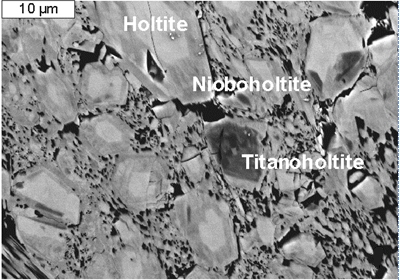The dumortierite
supergroup. II. Three new minerals from the Szklary pegmatite, SW
Poland: Nioboholtite,
(Nb0.6□0.4Al6BSi3O18,
titanoholtite, (Ti0.75
□0.25Al6BSi3O18,
and szklaryite, □Al6BAs3+3O15
Adam Pieczka
Department of Mineralogy, Petrography and
Geochemistry, AGH University of Science and Technology, Krakˇw, Poland
R James Evans and Lee A Groat
Department of Earth, Ocean and Atmospheric
Sciences, University of British Columbia, Vancouver, Canada
Edward S Grew
School of Earth and Climate Sciences, University of Maine,
Orono, Maine,
U.S.A.
Chi Ma, George R Rossman
Division of Geological and Planetary Sciences,
California Institute of Technology, Pasadena,
California, U.S.A.
ABSTRACT
Three
new minerals in the dumortierite supergroup were discovered in the Szklary pegmatite, Lower
Silesia, Poland.
Nioboholtite, endmember (Nb0.6□0.4Al6BSi3O18,
and titanoholtite, end-member Ti0.75
□0.25Al6BSi3O18,
are new members of the holtite group, whereas szklaryite, end-member □Al6BAs3+3O15,
is the first representative of a potential new group. Nioboholtite
occurs mostly
as overgrowths not exceeding 10 μm in thickness on cores of holtite.
Titanoholtite
forms patches up to 10 μm across
in the holtite
cores and streaks up to 5 μm wide along boundaries between
holtite cores and the nioboholtite rims.
Szklaryite
is found as a patch about 2 μm in size in As- and Sb- bearing
dumortierite enclosed in quartz. Titanoholtite
crystallized almost simultaneously with holtite and other Ta-dominant
minerals
such as tantalite-(Mn) and stibiotantalite and before nioboholtite,
which
crystallized simultaneously with stibiocolumbite during decreasing Ta
activity
in the pegmatite melt. Szklaryite crystallized after nioboholtite
during the
final stage of the Szklary pegmatite formation. Optical properties could only
be obtained on nioboholtite,
which is creamy-white to brownish yellow or grey-yellow in hand
specimen,
translucent, with a white streak, biaxial (−), nα
= 1.740-1.747, nβ
~ 1.76, nγ ~ 1.76, and Δ < 0.020.
Electron microprobe analyses of
nioboholtite, titanoholtite and szklaryite give respectively in wt%: P2O5
0.26, 0.01, 0.68; Nb2O5
5.21, 0.67, 0.17; Ta2O5
0.66, 1.18, 0.00; SiO2 18.68, 21.92, 12.78; TiO2
0.11, 4.00,
0.30; B2O3 (calc) 5.37,
5.45, 5.35; B2O3
(calc) 5.37, 5.45, 5.35; Al2O3
49.74, 50.02, 50.74; As2O3
5.92, 2.26, 16.02; Sb2O3
10.81, 11.48, 10.31; FeO 0.51,
0.31, 0.19; Sum 97.27, 97.11, 96.54, corresponding on the basis of O =
18-As-Sb
to (o0.44Nb0.25Al0.23Fe0.05Ta0.02Ti0.01)Σ1.00Al6B(Si2.02Sb0.48As0.39Al0.09P0.02)Σ3.00(O17.13o0.87)Σ18.00, (o0.36Ti0.32Al0.25Nb0.03Ta0.03Fe0.01)Σ1.00Al6B(Si2.33Sb0.50As0.15Al0.02)Σ3.00(O17.35o0.65)Σ18.00 and (o0.52Al0.43Ti0.02Fe0.02Nb0.01)Σ1.00
Al6B(Si1.38As1.05Sb0.46P0.06Al0.04)Σ3.00(O16.49o1.51)Σ18.00. Electron
backscattered diffraction indicate that the three minerals are
isostructural
with dumortierite, that is, orthorhombic symmetry, space group Pnma
(no. 62), and
unit-cell parameters close to a =
4.7001 ┼, b = 11.828 ┼, c = 20.243 ┼, with V
= 1125.36 ┼3 and Z
= 4; micro-Raman spectroscopy provided further confirmation for
titanoholtite. The
calculated density is 3.72 g/cm3
for nioboholtite, 3.66 g/cm3 for titanoholtite
and 3.71 g/cm3
for szklaryite. The strongest
lines in X-ray powder
diffraction patterns calculated
from the cell parameters of dumortierite of Moore
and Araki (1978) and the empirical formulae of
nioboholtite,
titanoholtite and szklaryite are, respectively [d,
┼, I (hkl)]:
10.2125, 67, 46, 19 (011); 5.9140,
40, 47, 57 (020); 5.8610, 66, 78, 100 (013); 3.4582, 63, 63, 60 (122);
3.4439,
36, 36, 34 (104); 3.2305, 1000, 100, 95 (123); 3.0675, 53, 53, 50
(105);
2.9305, 65, 59, 51 (026); 2.8945, 64, 65, 59 (132). The three minerals
have been approved by
the IMA CNMNC (IMA 2012-068, 069, 070) and were named for their
relationship to
holtite and occurrence in the Szklary pegmatite, respectively.





